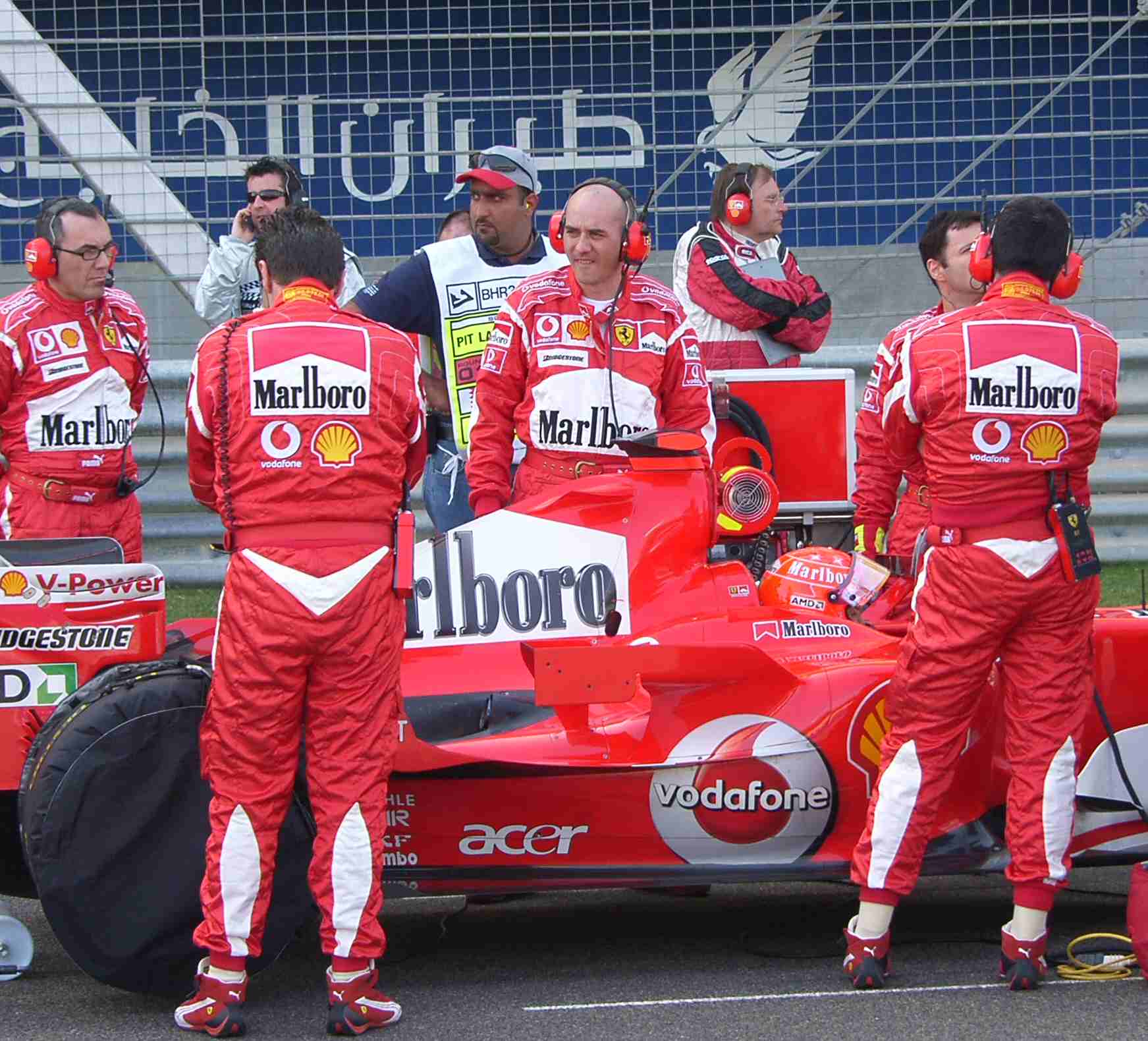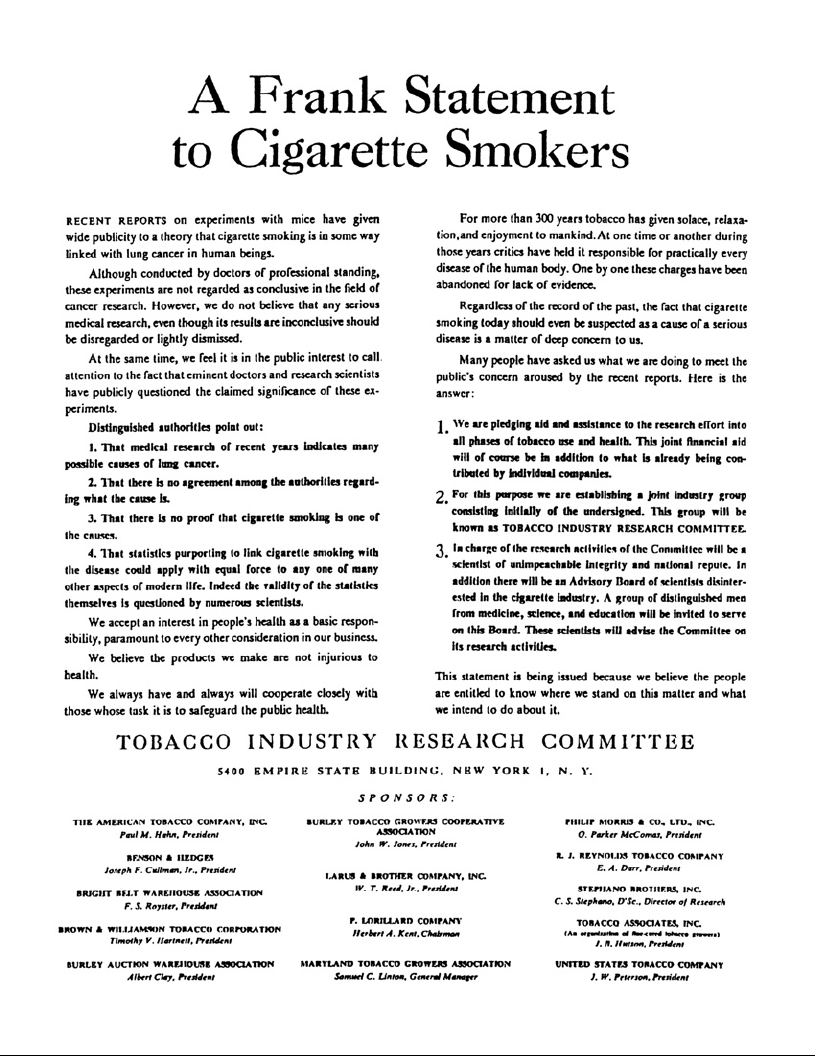|
Tar Derby
The tar derby is the period in the 1950s marked by a rapid influx in both Tobacco advertising, cigarette advertising focused on Tar (tobacco residue), tar content measurements to differentiate cigarettes and brand introduction or repositioning focusing on Cigarette filter, filter technology. The period ended in 1959 after the Federal Trade Commission (FTC) Chairman and several cigarette company presidents agreed to discontinue usage of tar or nicotine levels in advertisements. Leading up to the derby In 1950, the FTC responded to the trend in cigarette manufacturers’ advertising tactic of comparing health effects or tar and nicotine levels by issuing cease and desist orders for advertising campaigns using these. However, these orders did not cover newly introduced brands of cigarettes. At the same time, three significant scientific articles were released, two in one issue of the ''Journal of the American Medical Association'' and a third in the ''BMJ, British Medical Journa ... [...More Info...] [...Related Items...] OR: [Wikipedia] [Google] [Baidu] |
Tobacco Advertising
Nicotine marketing is the marketing of nicotine-containing products or use. Traditionally, the tobacco industry markets cigarette smoking, but it is increasingly marketing other products, such as electronic cigarettes and heated tobacco products. Products are marketed through social media, stealth marketing, mass media, and sponsorship (particularly of sporting events). Expenditures on nicotine marketing are in the tens of billions a year; in the US alone, spending was over US$1 million per hour in 2016; in 2003, per-capita marketing spending was $290 per adult smoker, or $45 per inhabitant. Nicotine marketing is increasingly regulated; some forms of nicotine advertising are banned in many countries. The World Health Organization recommends a complete tobacco advertising ban. Effects The effectiveness of tobacco marketing in increasing consumption of tobacco products is widely documented. Advertisements cause new people to become addicted, mostly when they are minors. Ads ... [...More Info...] [...Related Items...] OR: [Wikipedia] [Google] [Baidu] |
Health Effects Of Tobacco
Tobacco use has predominantly negative effects on human health and concern about health effects of tobacco has a long history. Research has focused primarily on cigarette smoking. Tobacco smoke contains more than 70 chemicals that cause cancer. Tobacco also contains nicotine, which is a highly addictive psychoactive drug. When tobacco is smoked, nicotine causes physical and psychological dependency. Cigarettes sold in underdeveloped countries tend to have higher tar content, and are less likely to be filtered, potentially increasing vulnerability to tobacco smoking–related disease in these regions. Tobacco use is the single greatest cause of preventable death globally. As many as half of people who use tobacco die from complications of tobacco use. The World Health Organization (WHO) estimates that each year tobacco causes about 6 million deaths (about 10% of all deaths) with 600,000 of these occurring in non-smokers due to second-hand smoke. Tobacco is estimated to ha ... [...More Info...] [...Related Items...] OR: [Wikipedia] [Google] [Baidu] |
Lucky Strike
Lucky Strike is an American brand of cigarettes owned by the British American Tobacco group. Individual cigarettes of the brand are often referred to colloquially as "Luckies." Throughout their 150 year history, Lucky Strike has had fluctuating market relevance, with the brand peaking in the 1930s and 1940s, when it became one of the top-selling cigarette brands in the United States . Name Lucky Strike was introduced as a brand of chewing tobacco by American firm R.A. Patterson in 1871, and evolved into a cigarette by the early 1900s. The brand name was inspired by the gold rushes of the era, during which only about four miners in a thousand were fortunate enough to strike gold, and was intended to connote a top-quality blend. A well-circulated urban legend holds that the name "Lucky Strike" referred to the presence of marijuana in some cigarette packs. History The brand was first introduced by R. A. Patterson of Richmond, Virginia, in 1871 as cut plug and later a cigarette ... [...More Info...] [...Related Items...] OR: [Wikipedia] [Google] [Baidu] |
Tareyton
Tareyton is an American brand of cigarettes, currently owned and manufactured by the R.J. Reynolds Tobacco Company. History Tareyton began as a variation of Herbert Tareyton cork-tipped non-filter cigarettes (whose slogan was, "There's ''something'' about them you'll like"). As filters gained in popularity in the late 1950s, Tareyton was created in 1954 as the filtered version of Herbert Tareyton, minus the cork tip. Tareyton is currently produced by R.J. Reynolds Tobacco Company, and can be found on the internet and specialty tobacco stores, but is no longer sufficiently popular to be stocked in many stores or receive marketing and advertising from R.J. Reynolds. Tareyton's filter features a two-part design of fiber and activated charcoal. Advertising Tareyton was perhaps better known for its advertisements than its sales. In the 1930s, various cigarette cards were created to promote the original Herbert Tareyton brand. In the mid-1960s, Tareyton's TV and print advertise ... [...More Info...] [...Related Items...] OR: [Wikipedia] [Google] [Baidu] |
Pall Mall (cigarette)
Pall Mall (, or adopted ) is a British brand of cigarettes produced by British American Tobacco. History The Pall Mall brand was introduced in 1899 by the Black Butler Company (UK) in an attempt to cater to the upper class with the first "premium" cigarette. It is named after Pall Mall, a well-known street in the St James's area of London, containing several of the private clubs which such people patronized. In 1907, Pall Mall was acquired by the American Tobacco Company with the sale of Butler & Butler. The new owners used the premium brand to test innovations in cigarette design, such as, in 1939, the "king-size" (now the standard size for cigarettes at 85 mm, although today that includes the filter length), and a new way of stuffing tobacco that supposedly made cigarettes easier on the throat. Pall Mall reached the height of its popularity in 1960 when it was the number one brand of cigarette in America. Capitalising on their popularity, the company introduced "lon ... [...More Info...] [...Related Items...] OR: [Wikipedia] [Google] [Baidu] |
Chesterfield (cigarette)
Chesterfield is a brand of cigarette, named after Chesterfield County, Virginia. The brand is owned by conglomerate Altria and produced by its subsidiary Philip Morris USA. History A blend of Turkish tobacco, Turkish and Virginia tobacco, Chesterfields were introduced by the Drummond Tobacco Company of St. Louis, Missouri in 1873. The company was acquired by American Tobacco Company in 1898, who manufactured Chesterfields until 1911. In 1912 the brand was taken over by Liggett Group, Liggett & Myers and production moved to Durham, North Carolina."Chesterfield" FirstVersions The brand was acquired by Altria Group, Philip Morris (now Altria) in 1999. Chesterfield was the first cigarette to add an extra layer of wrapping to their pack to preserve moisture (1916). In 1926, Chesterfield's "Blow some my way" advertising c ... [...More Info...] [...Related Items...] OR: [Wikipedia] [Google] [Baidu] |
Philip Morris USA
Philip Morris USA is the American tobacco division of the American tobacco corporation Altria, Altria Group. History Creation The company's namesake Philip Morris (tobacconist), Philip Morris was born in Whitechapel, United Kingdom in 1835, the son of a recent immigrant from Germany who had taken the name Bernard Morris. In 1847, the family opened a shop in London. The first cigarettes that Philip Morris made were in 1854 and were known as "Philip Morris English Ovals," a non-filter brand of oval-shaped cigarettes that were manufactured in very limited quantities until discontinuation in 2017. Early years In 1902, Philip Morris & Co. Ltd. was Incorporation (business), incorporated in New York City. George J. Whelan bought the American division of the company in 1919 and created Philip Morris & Co. Ltd., Inc., along with fellow shareholders Reuben M. Ellis and Leonard B. McKitterick. In 1929, the company made its first cigarettes in Richmond, using an existing factory the ... [...More Info...] [...Related Items...] OR: [Wikipedia] [Google] [Baidu] |
Reader’s Digest
''Reader's Digest'' is an American general-interest family magazine, published ten times a year. Formerly based in Chappaqua, New York, it is now headquartered in midtown Manhattan. The magazine was founded in 1922 by DeWitt Wallace and his wife Lila Bell Wallace. For many years, ''Reader's Digest'' was the best-selling consumer magazine in the United States; it lost the distinction in 2009 to '' Better Homes and Gardens''. According to Mediamark Research (2006), ''Reader's Digest'' reached more readers with household incomes of over $100,000 than '' Fortune'', ''The Wall Street Journal'', '' Business Week'', and '' Inc.'' combined. Global editions of ''Reader's Digest'' reach an additional 40 million people in more than 70 countries, via 49 editions in 21 languages. The periodical has a global circulation of 10.5 million, making it the largest paid-circulation magazine in the world. It is also published in Braille, digital, audio, and a large type called "Reader's Digest Lar ... [...More Info...] [...Related Items...] OR: [Wikipedia] [Google] [Baidu] |
Scientific Proof
Scientific evidence is evidence that serves to either support or counter a scientific theory or hypothesis, although scientists also use evidence in other ways, such as when applying theories to practical problems. "Discussions about empirical evidence have tended to focus on epistemological questions regarding its role in theory testing ... even though empirical evidence also plays important and philosophically interesting roles in other areas including scientific discovery, the development of experimental tools and techniques, and the application of scientific theories to practical problems." Such evidence is expected to be empirical evidence and interpretable in accordance with scientific methods. Standards for scientific evidence vary according to the field of inquiry, but the strength of scientific evidence is generally based on the results of statistical analysis and the strength of scientific controls. Principles of inference A person's assumptions or beliefs about ... [...More Info...] [...Related Items...] OR: [Wikipedia] [Google] [Baidu] |
Loophole
A loophole is an ambiguity or inadequacy in a system, such as a law or security, which can be used to circumvent or otherwise avoid the purpose, implied or explicitly stated, of the system. Originally, the word meant an arrowslit, a narrow vertical window in a wall through which an archer (or, later, gunman) could shoot. Loopholes were commonly used in U.S. forts built during the 1800s. Located in the sally port, a loophole was considered a last ditch defense, where guards could close off the inner and outer doors trapping enemy soldiers and using small arms fire through the slits. Loopholes are distinct from lacunae, although the two terms are often used interchangeably. In a loophole, a law addressing a certain issue exists, but can be legally circumvented due to a technical defect in the law, such as a situation where the details are under-specified. A lacuna, on the other hand, is a situation in which no law exists in the first place to address that particular issue. Use a ... [...More Info...] [...Related Items...] OR: [Wikipedia] [Google] [Baidu] |
A Frank Statement To Cigarette Smokers
''A Frank Statement to Cigarette Smokers'' was a historic first advertisement in a campaign run by major American tobacco companies on January 4, 1954, to create doubt by disputing recent scientific studies linking smoking cigarettes to lung cancer and other dangerous health effects. Reaching an estimated 43 million people through more than 400 newspapers throughout the United States, ''A Frank Statement to Cigarette Smokers'' and subsequent advertisements were designed by public relations firm Hill & Knowlton to socially engineer the public's perceptions of tobacco and to instill doubt about scientific research linking disease and smoking. As a result of ''A Frank Statement'' and tobacco advertisements that still exist today, the tobacco industry continues to expand its markets by avoiding health concerns and portraying its products in a positive light. Historical context Reports of a link between tobacco and lung cancer emerged ... [...More Info...] [...Related Items...] OR: [Wikipedia] [Google] [Baidu] |







